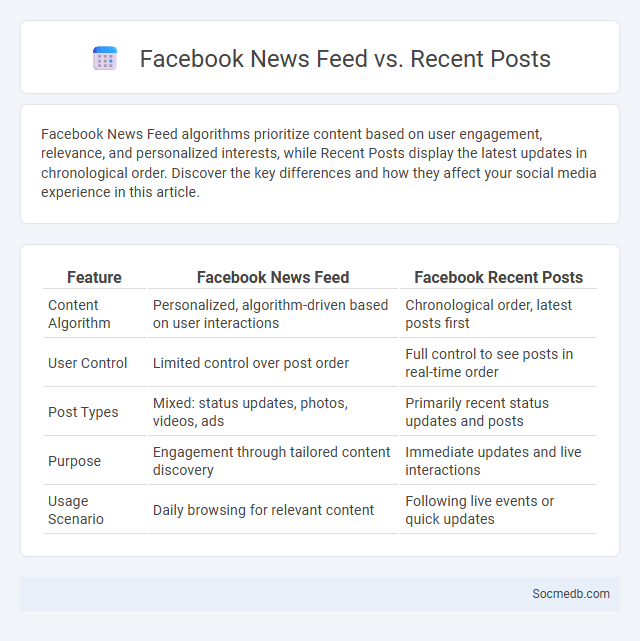
Photo illustration: Facebook News Feed vs Recent Posts
Facebook News Feed algorithms prioritize content based on user engagement, relevance, and personalized interests, while Recent Posts display the latest updates in chronological order. Discover the key differences and how they affect your social media experience in this article.
Table of Comparison
| Feature | Facebook News Feed | Facebook Recent Posts |
|---|---|---|
| Content Algorithm | Personalized, algorithm-driven based on user interactions | Chronological order, latest posts first |
| User Control | Limited control over post order | Full control to see posts in real-time order |
| Post Types | Mixed: status updates, photos, videos, ads | Primarily recent status updates and posts |
| Purpose | Engagement through tailored content discovery | Immediate updates and live interactions |
| Usage Scenario | Daily browsing for relevant content | Following live events or quick updates |
Understanding Facebook’s News Feed
Facebook's News Feed uses an advanced algorithm to prioritize content based on user engagement signals such as likes, comments, and shares, ensuring personalized and relevant updates. The algorithm incorporates factors like content popularity, recency, and user relationships to curate feeds tailored to individual preferences. Understanding these dynamics helps marketers optimize posts for higher visibility and enhanced user interaction.
What Are Recent Posts on Facebook?
Recent posts on Facebook typically include updates about trending news, viral videos, user-generated content, and live event streams. Users frequently share personal milestones, opinions on current events, and promotional content from businesses leveraging Facebook's algorithm for broader reach. Engagement metrics such as likes, comments, and shares on these posts help determine their visibility and popularity across different demographic segments.
Key Differences Between News Feed and Recent Posts
The News Feed on social media platforms curates content using algorithms that prioritize posts based on relevance, user interactions, and engagement metrics, ensuring Your feed highlights popular and personalized updates. Recent Posts display content in chronological order, showing the latest activity from friends or pages without prioritizing based on popularity or interaction level. Understanding these key differences helps You manage how you consume and interact with real-time versus algorithmically filtered social media content.
How Facebook Ranks Content in the News Feed
Facebook prioritizes content in your News Feed based on factors like user engagement, relevancy, and recency. The algorithm considers interactions such as likes, comments, and shares, as well as your relationship with the content creator. Understanding these ranking signals helps optimize your posts for better visibility.
Pros and Cons of News Feed vs Recent Posts
News feed algorithms prioritize content based on user engagement, increasing relevance and personalized experience but potentially creating echo chambers and limiting exposure to diverse viewpoints. Recent posts display content chronologically, ensuring timely updates and equal visibility but often overwhelming users with less relevant information. Choosing between news feed and recent posts depends on whether users prefer curated content for engagement or a straightforward, real-time content stream.
Impact on User Engagement and Experience
Social media platforms significantly enhance user engagement by enabling real-time interactions, personalized content feeds, and community building features. Advanced algorithms analyze user behaviors to deliver tailored content, increasing time spent on platforms and fostering deeper connections. Enhanced user experience is driven by intuitive interfaces, interactive multimedia, and seamless integration across devices, promoting sustained participation and satisfaction.
Algorithmic vs Chronological Sorting Explained
Social media platforms use algorithmic sorting to prioritize content based on user behavior, engagement metrics, and relevance, enhancing personalized experiences. Chronological sorting displays posts in the order they were published, providing a real-time, linear feed without prioritization. Understanding these sorting methods helps users optimize content visibility and engagement strategies effectively.
Customizing Your Facebook Viewing Preference
Customizing your Facebook viewing preference enhances user experience by allowing tailored content feeds based on interests, interactions, and page follows. Adjusting settings such as prioritizing who to see first, unfollowing posts, and managing notifications ensures relevant updates appear prominently. This personalized approach increases engagement and reduces information overload on the platform.
Privacy and Content Visibility Implications
Social media platforms collect vast amounts of personal data, raising significant privacy concerns related to unauthorized data sharing and surveillance. Content visibility settings impact user control, often leading to unintended exposure of sensitive information to wider audiences. Implementing robust privacy controls and encryption protocols is crucial to safeguard user data and manage content accessibility effectively.
Tips for Maximizing Your Facebook Feed Experience
Curate your Facebook feed by actively following pages and groups that align with your interests to ensure relevant content appears regularly. Utilize Facebook's preference settings to prioritize posts from friends and pages you value most, enhancing the quality of your feed. Engaging with posts through likes, comments, and shares helps tailor the algorithm to better suit your preferences and maximize your Facebook experience.
 socmedb.com
socmedb.com